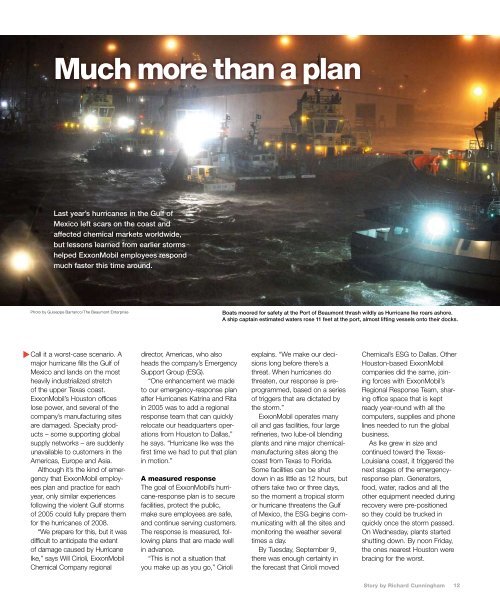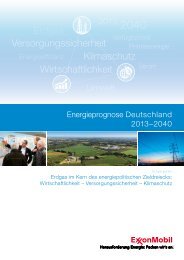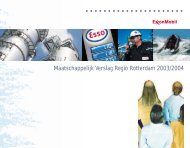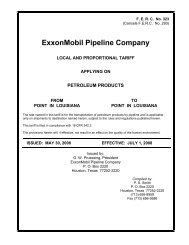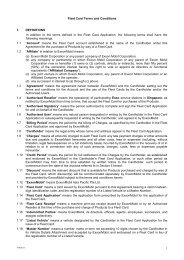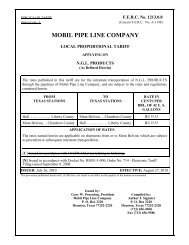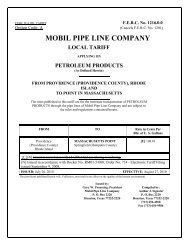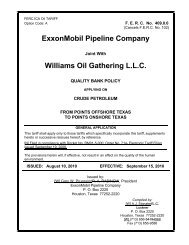ExxonMobil and Abu Dhabi
ExxonMobil and Abu Dhabi
ExxonMobil and Abu Dhabi
Create successful ePaper yourself
Turn your PDF publications into a flip-book with our unique Google optimized e-Paper software.
Much more than a plan<br />
Last year’s hurricanes in the Gulf of<br />
Mexico left scars on the coast <strong>and</strong><br />
affected chemical markets worldwide,<br />
but lessons learned from earlier storms<br />
helped <strong>ExxonMobil</strong> employees respond<br />
much faster this time around.<br />
Photo by Guiseppe Barranco/The Beaumont Enterprise<br />
Call it a worst-case scenario. A<br />
major hurricane fills the Gulf of<br />
Mexico <strong>and</strong> l<strong>and</strong>s on the most<br />
heavily industrialized stretch<br />
of the upper Texas coast.<br />
<strong>ExxonMobil</strong>’s Houston offices<br />
lose power, <strong>and</strong> several of the<br />
company’s manufacturing sites<br />
are damaged. Specialty products<br />
– some supporting global<br />
supply networks – are suddenly<br />
unavailable to customers in the<br />
Americas, Europe <strong>and</strong> Asia.<br />
Although it’s the kind of emergency<br />
that <strong>ExxonMobil</strong> employees<br />
plan <strong>and</strong> practice for each<br />
year, only similar experiences<br />
following the violent Gulf storms<br />
of 2005 could fully prepare them<br />
for the hurricanes of 2008.<br />
“We prepare for this, but it was<br />
difficult to anticipate the extent<br />
of damage caused by Hurricane<br />
Ike,” says Will Cirioli, <strong>ExxonMobil</strong><br />
Chemical Company regional<br />
director, Americas, who also<br />
heads the company’s Emergency<br />
Support Group (ESG).<br />
“One enhancement we made<br />
to our emergency-response plan<br />
after Hurricanes Katrina <strong>and</strong> Rita<br />
in 2005 was to add a regional<br />
response team that can quickly<br />
relocate our headquarters operations<br />
from Houston to Dallas,”<br />
he says. “Hurricane Ike was the<br />
first time we had to put that plan<br />
in motion.”<br />
A measured response<br />
The goal of <strong>ExxonMobil</strong>’s hurricane-response<br />
plan is to secure<br />
facilities, protect the public,<br />
make sure employees are safe,<br />
<strong>and</strong> continue serving customers.<br />
The response is measured, following<br />
plans that are made well<br />
in advance.<br />
“This is not a situation that<br />
you make up as you go,” Cirioli<br />
Boats moored for safety at the Port of Beaumont thrash wildly as Hurricane Ike roars ashore.<br />
A ship captain estimated waters rose 11 feet at the port, almost lifting vessels onto their docks.<br />
explains. “We make our decisions<br />
long before there’s a<br />
threat. When hurricanes do<br />
threaten, our response is preprogrammed,<br />
based on a series<br />
of triggers that are dictated by<br />
the storm.”<br />
<strong>ExxonMobil</strong> operates many<br />
oil <strong>and</strong> gas facilities, four large<br />
refineries, two lube-oil blending<br />
plants <strong>and</strong> nine major chemicalmanufacturing<br />
sites along the<br />
coast from Texas to Florida.<br />
Some facilities can be shut<br />
down in as little as 12 hours, but<br />
others take two or three days,<br />
so the moment a tropical storm<br />
or hurricane threatens the Gulf<br />
of Mexico, the ESG begins communicating<br />
with all the sites <strong>and</strong><br />
monitoring the weather several<br />
times a day.<br />
By Tuesday, September 9,<br />
there was enough certainty in<br />
the forecast that Cirioli moved<br />
Chemical’s ESG to Dallas. Other<br />
Houston-based <strong>ExxonMobil</strong><br />
companies did the same, joining<br />
forces with <strong>ExxonMobil</strong>’s<br />
Regional Response Team, sharing<br />
office space that is kept<br />
ready year-round with all the<br />
computers, supplies <strong>and</strong> phone<br />
lines needed to run the global<br />
business.<br />
As Ike grew in size <strong>and</strong><br />
continued toward the Texas-<br />
Louisiana coast, it triggered the<br />
next stages of the emergencyresponse<br />
plan. Generators,<br />
food, water, radios <strong>and</strong> all the<br />
other equipment needed during<br />
recovery were pre-positioned<br />
so they could be trucked in<br />
quickly once the storm passed.<br />
On Wednesday, plants started<br />
shutting down. By noon Friday,<br />
the ones nearest Houston were<br />
bracing for the worst.<br />
Story by Richard Cunningham<br />
12


